
The European beewolf, also known as the bee-killer wasp or the bee-eating philanthus, is a solitary wasp that lives in the Western Palearctic and Afrotropics. Although the adults of the species are herbivores, the species derives its name from the behaviour of the inseminated females, who hunt Western honey bees. The female places several of its paralysed prey together with an egg in a small underground chamber, to serve as food for the wasp larvae. All members of the genus Philanthus hunt various species of bees, but P. triangulum is apparently the only one that specialises in Western honey bees.

A wasp is any insect of the narrow-waisted suborder Apocrita of the order Hymenoptera which is neither a bee nor an ant; this excludes the broad-waisted sawflies (Symphyta), which look somewhat like wasps, but are in a separate suborder. The wasps do not constitute a clade, a complete natural group with a single ancestor, as bees and ants are deeply nested within the wasps, having evolved from wasp ancestors. Wasps that are members of the clade Aculeata can sting their prey.

Dolichovespula adulterina is a species of parasitic social wasp found in the Palearctic region. D. adulterina feeds on a variety of foods, including insects, spiders, arthropods, meat, molluscs, fruit, nectar, and larval secretions. D. adulterina was formerly considered to be synonymous with D. arctica from the Holarctic region, but more recent research indicates that D. arctica is a separate species.

Vespula rufa, commonly known as the red wasp, is a social wasp species belonging to the genus Vespula. It is found in northern and central Europe, parts of Asia, and northern parts of North America. Vespula rufa is characterised by red-brown markings and body segmentation, with the appearance varying amongst the different roles of individuals in the species. These wasps build small nests in dry banks underground that are not far below the surface. The colony cycle begins in the fall. Vespula rufa feed on live insects. One interesting fact about Vespula rufa is that the queen policing occurs in the species, and that worker policing occurs at much lower rates than other species in the genus Vespula. There are predators and parasites of the species. The species goes through a series of events before leaving the nest.
Dipogon bifasciatus is a spider wasp from the family Pompilidae.
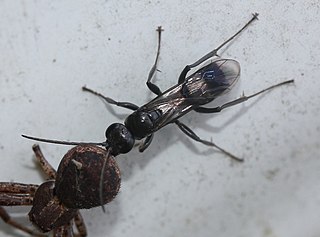
Dipogon is a genus of spider wasps of the family Pompilidae in the subfamily Pepsinae. They are found in Europe, Asia, and North America. Their generic name comes from the characteristic long bristle tufts just below the mandibles, which are used to carry material to construct the cells in the nest, and for constructing the nest.

Dipogon subintermedius is a spider wasp from the family Pompilidae.
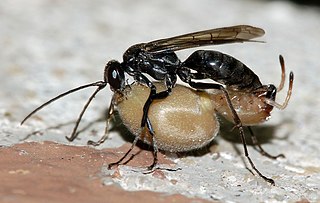
Auplopus carbonarius is a spider wasp of the family Pompilidae. Uniquely among the British group it constructs a nest of barrel-shaped cells in which spiders are stored and the larvae develop.
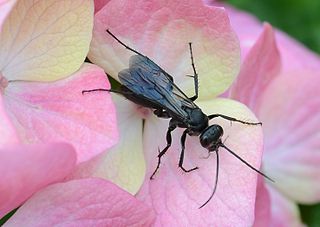
Anoplius nigerrimus is one of the most common spider wasps, or pompilids, in Europe. They are mostly black and the females are 6–8 mm long while males measure 5–8 mm. This species may be distinguished from the related Anoplius concinnus and Anoplius caviventris by the 20 setae, or hairs, on the forehead rather than 60 or 45.
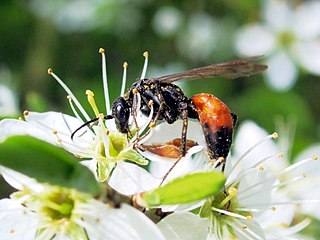
Priocnemis perturbator is a relatively large species of spider wasp which is quite common in Europe. It was previously considered to be the same species as the closely related P. susterai which were lumped as P. fuscus and this means that some early observations of behaviour are not applicable to either species. Even now the two species need close observation under a microscope or hand lens to distinguish them from each other.
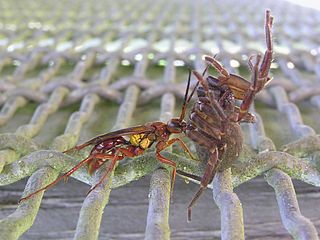
Sphictostethus nitidus, the golden hunter wasp or red spider wasp, is a species of pepsid spider wasp endemic to New Zealand.

Arachnospila trivialis is a widespread spider wasp of sandy soil areas of the Palaearctic.
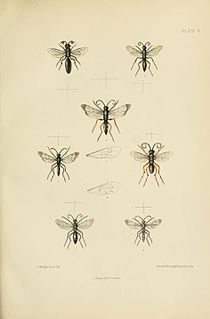
Agenioideus cinctellus is a spider wasp of the subfamily Pompilinae with a Palearctic distribution.

Caliadurgus fasciatellus is a species of spider wasp from the subfamily Pepsinae found from Western Europe to the Far East of Asia.
Priocnemis susterai is a large species of pepsine spider wasp and is, with Priocnemis perturbator and Priocnemis coriacea, one of three similar species of the subgenus Umbripennis found in Great Britain. All three of these species are characterised by having plentiful erect hair on the face and propodum.

Xysticus cristatus, the common crab spider, is a European spider from the family Thomisidae.

Symmorphus bifasciatus, the willow mason-wasp, is a species of potter wasp, from the subfamily Eumeninae of the social wasp family Vespidae which is widely distributed in the Palearctic region.
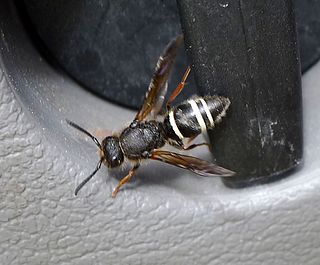
Ancistrocerus scoticus is a Palearctic species of potter wasp.
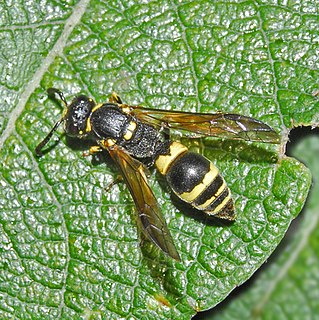
Symmorphus gracilis is a species of tube-nesting wasps.

















